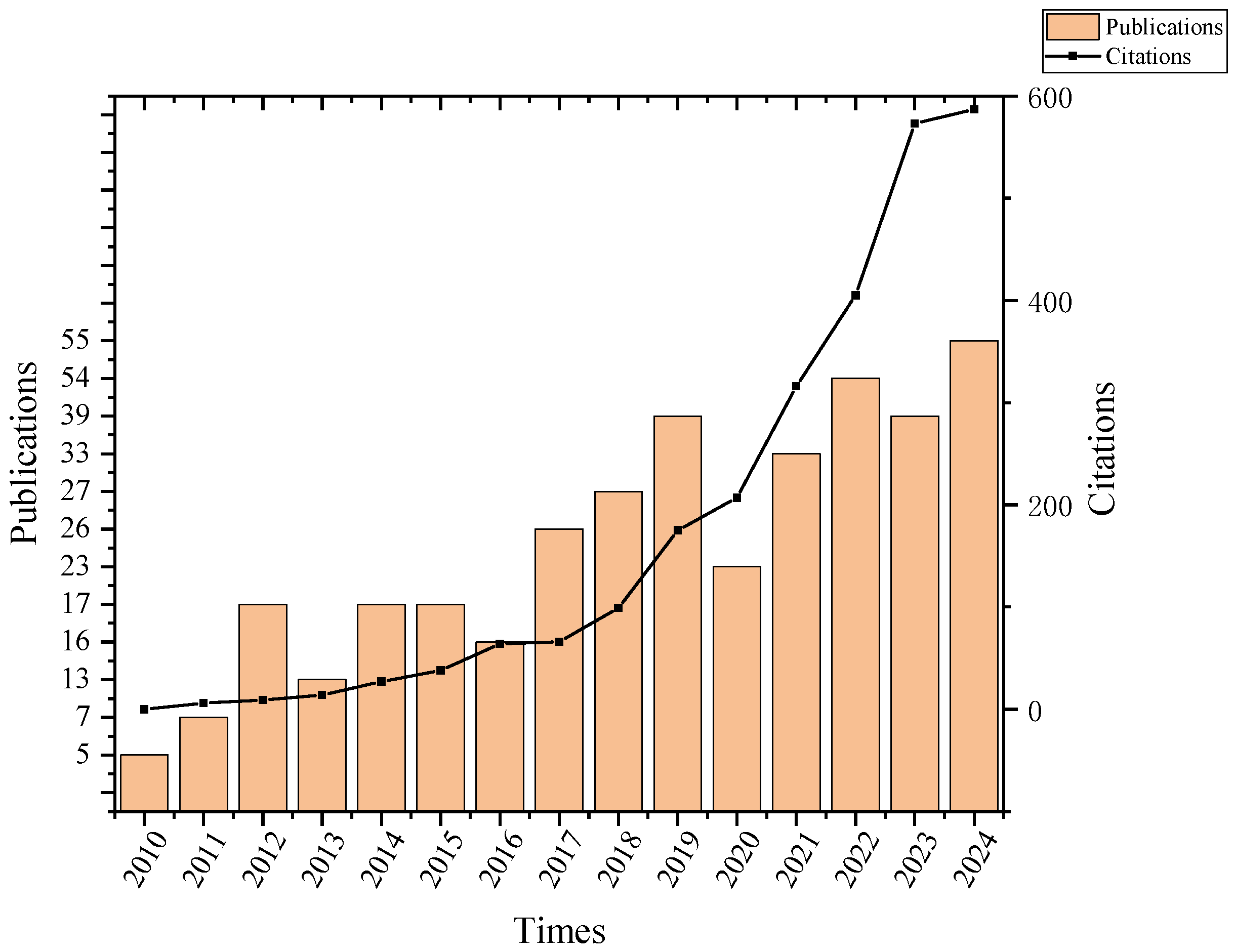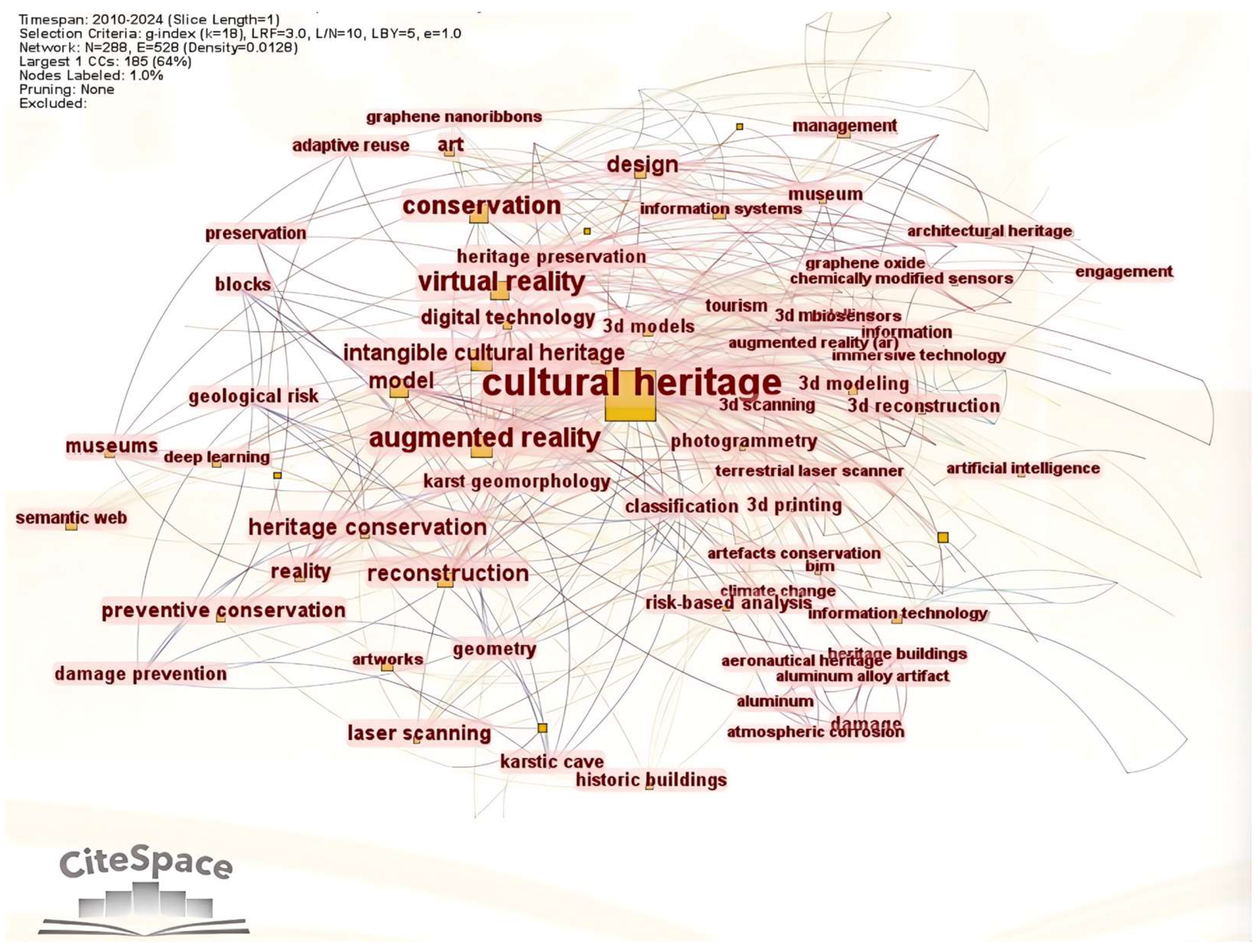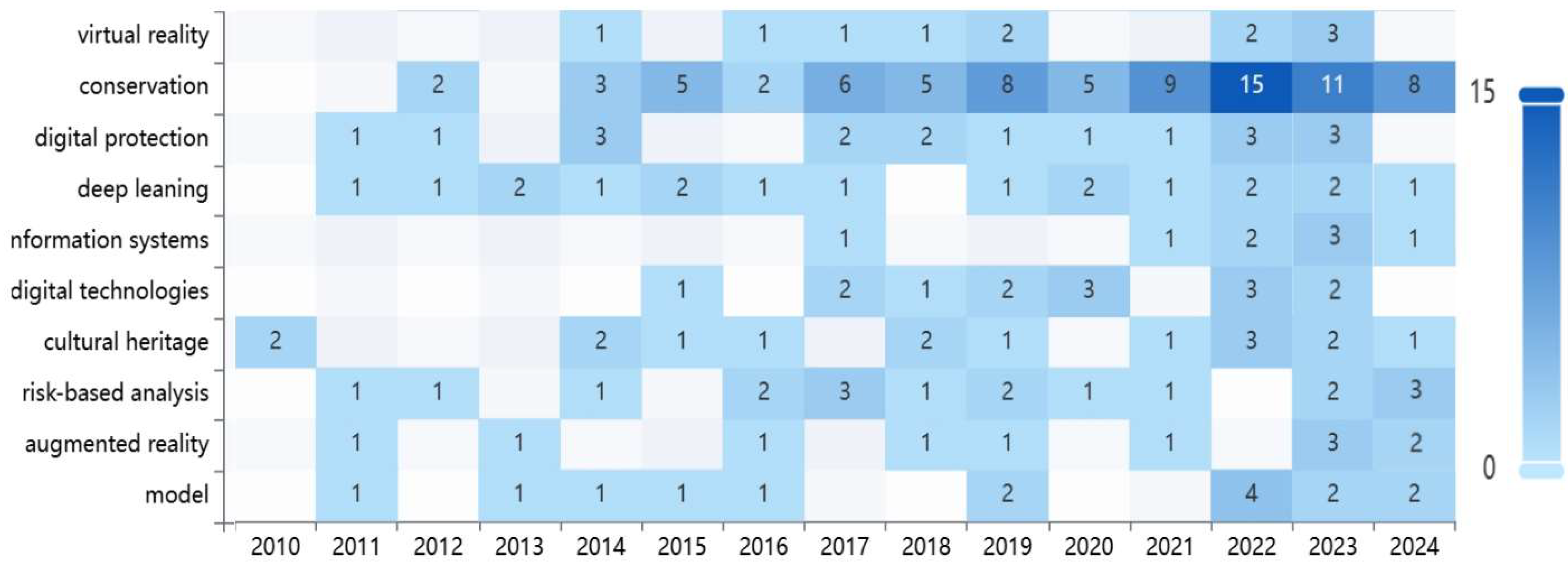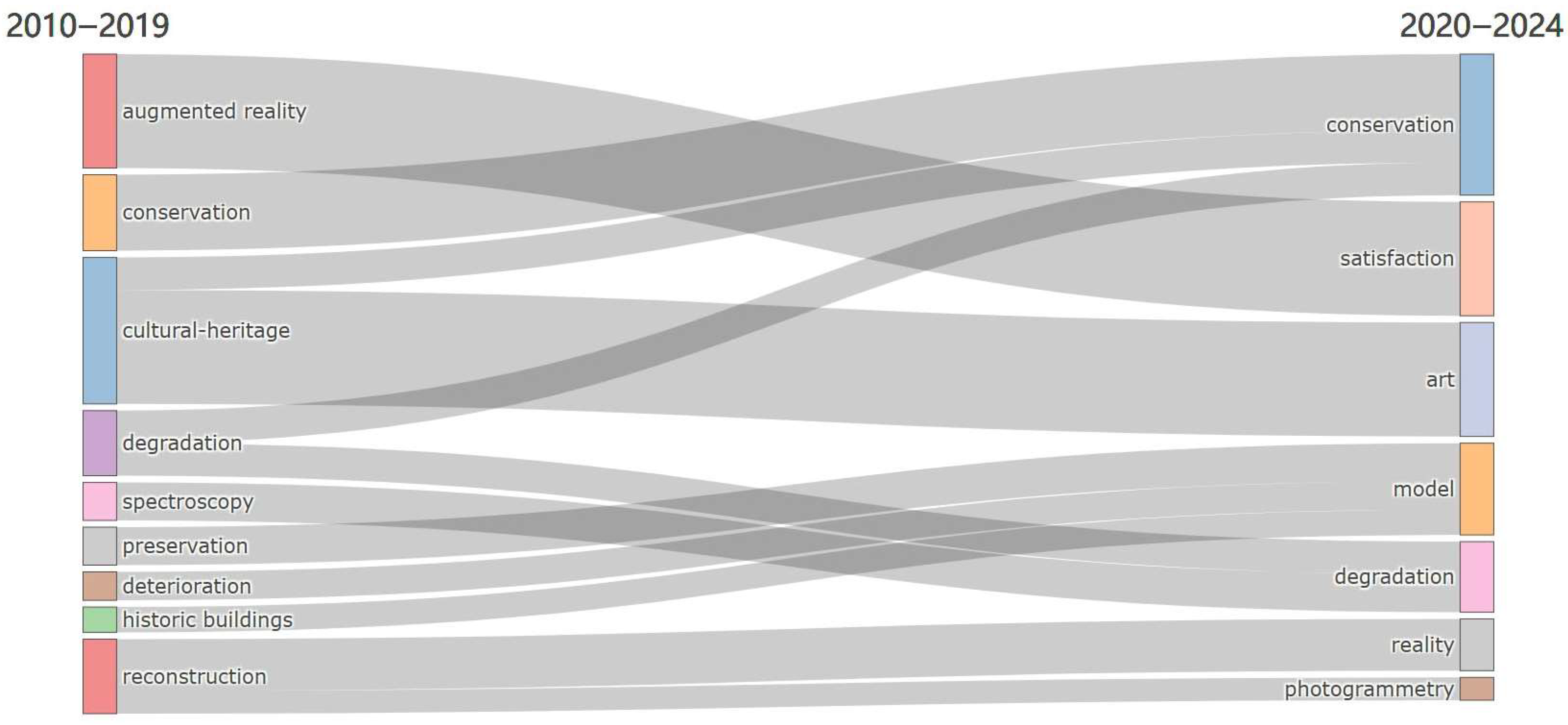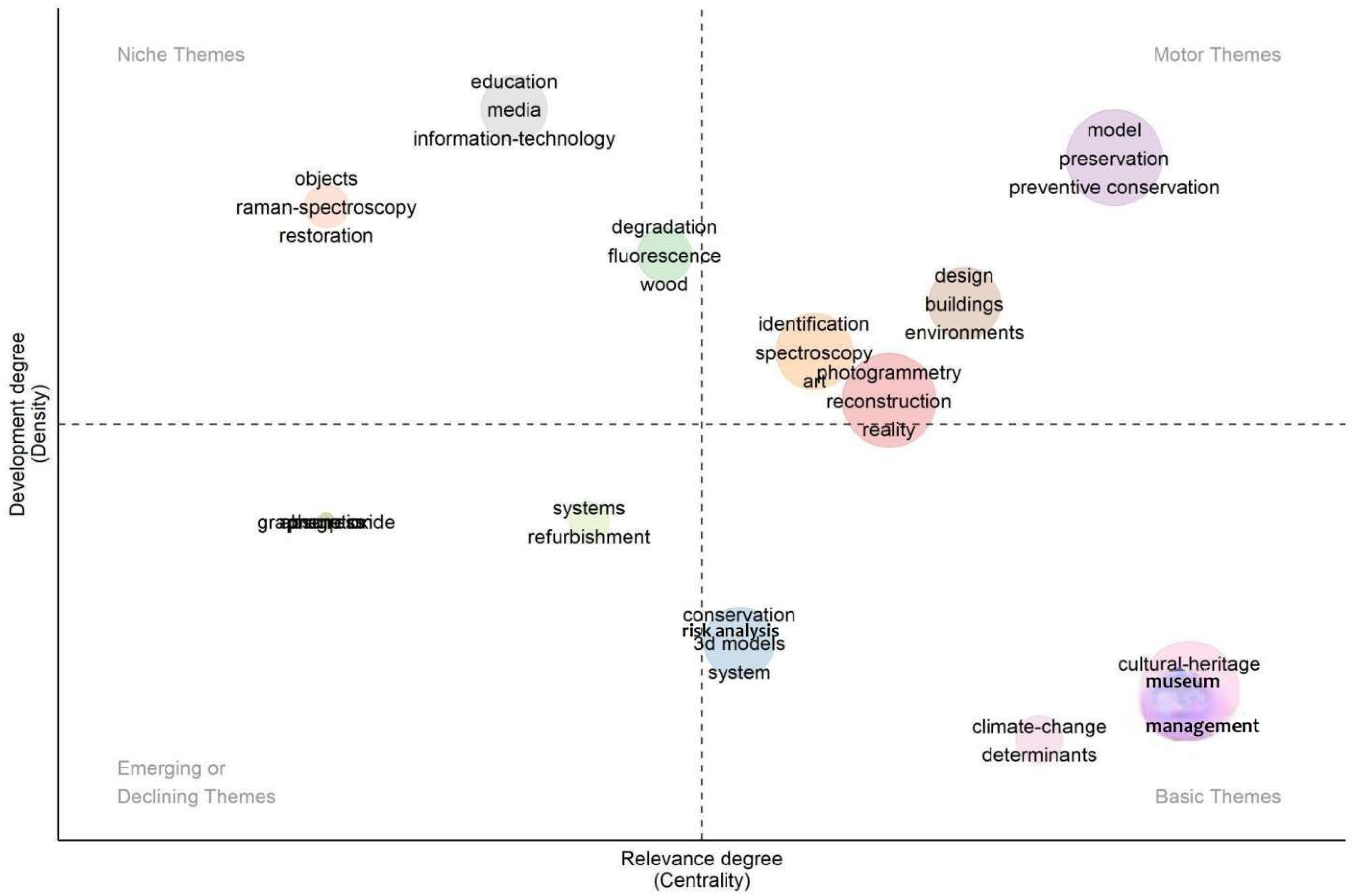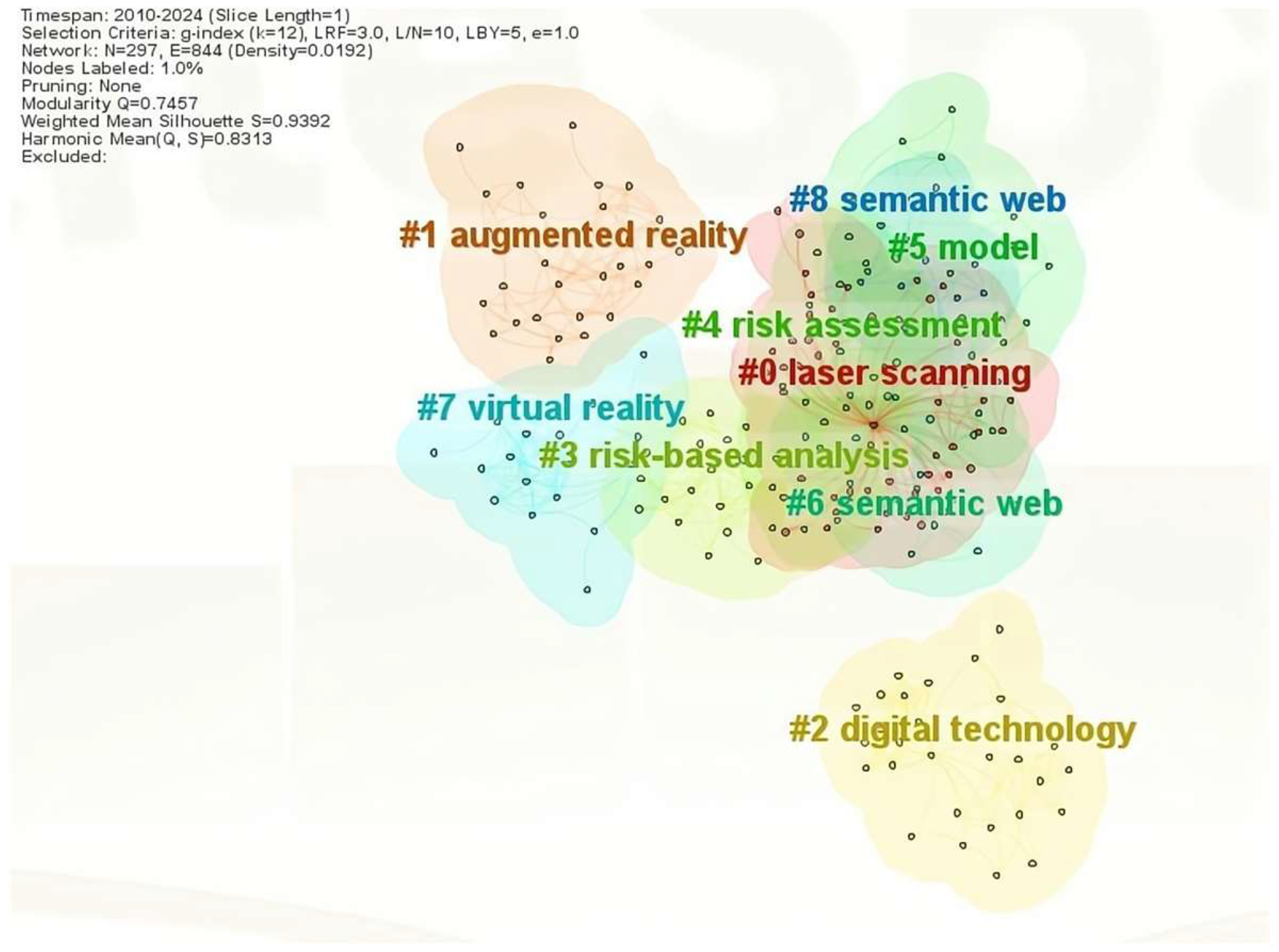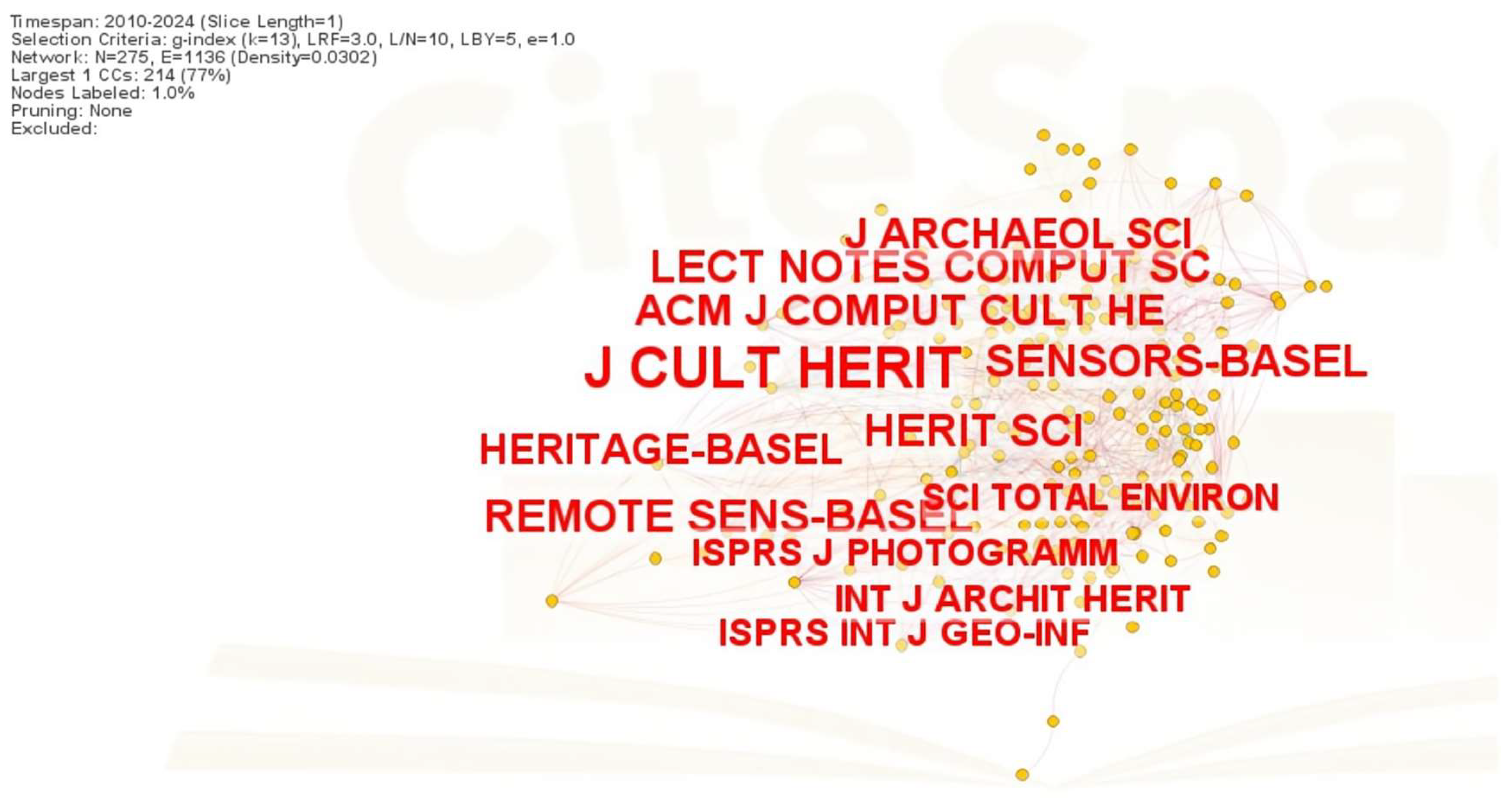1. Introduction
Since the 1930s, the concept of preventive conservation of cultural relics has first become an international consensus, marking a shift towards a risk prevention and control management paradigm. This evolutionary trajectory implies that the technical methodologies for the preventive safeguarding of cultural relics have progressed from the initial stage of “elementary temperature and humidity modulation” to incorporating a more expansive gamut of environmental management for the preservation of cultural heritage [
1]. Presently, this paradigm is undergoing a further metamorphosis towards embracing “risk management”, with science and technology playing a cardinal role in both orienting and augmenting its developmental progression [
2,
3].
Internationally, the updated definition of “preventive conservation” of cultural objects explicitly includes “risk assessment”. Nine categories of risk factors for preventive conservation have been identified, and environmental control guidelines, risk analysis models and response strategies have been extensively discussed [
4,
5,
6]. Under the organization of ICCROM, training courses on risk management for preventive conservation of cultural heritage have been promoted globally, and the ABC methodology for risk management for preventive conservation of cultural heritage as well as risk management guidelines have been published. From 2011 to 2017, ICCROM and UNESCO organized 15 experts from around the world to design the RE-ORG methodology (Reorganization of Repositories of Collections) which was applied in 83 museums in 27 countries through hands-on workshops, mentorship sessions, and online training.
The protection of cultural relics in Chinese collections has developed the concept of preventive protection centered on “stability and cleanliness” and has started to introduce risk management methods. Preventive protection methods clearly include risk assessment, risk monitoring and early warning practices, research on risk quantification methods, thematic study of risk evaluation techniques, analysis of risk management application cases, and exploration and proposal of a preventive protection risk management framework.
In recent years, scholarly efforts have begun to map the intersection of technology and cultural heritage through various literature reviews and bibliometric studies. Piccialli and Chianese (2017) [
7] earlier highlighted the trends and challenges of new technologies in the field, emphasizing the need for interdisciplinary approaches but without a quantitative bibliometric foundation. Mendoza et al. (2023) [
2] conducted a systematic review of preservation technologies, and proved the types of technologies that have been used to conserve and preserve cultural heritage globally between 2018 and 2022. The review highlighted three primary categories: 3D digital technologies (encompassing 3D modeling, 3D scanning, 3D visualization), AR/VR (immersive and non-immersive), and IoT platform configuration, but it does focus specifically on the risk management paradigm. More recently, Jiang et al. (2025) [
8] conducted a bibliometric analysis focused on immersive technologies in the field of cultural heritage preservation, demonstrating the value of this approach. However, their research scope was limited to specific technological domains such as technological applications, public engagement, and education, and did not extend to risk prevention and control in cultural heritage [
8]. While these studies provide valuable insights, there remains a lack of a comprehensive bibliometric analysis specifically dedicated to the application of frontier technologies within the risk management framework for cultural heritage conservation. Therefore, this study employs bibliometric methods to systematically map research outcomes from 2010 to 2024 in this interdisciplinary field, aiming to elucidate the knowledge structure, evolutionary trajectory, and key research fronts within the framework of cultural heritage risk management, thereby achieving a systematic analysis of the integration of the frontier technologies with cultural heritage risk management frameworks.
Therefore, the application of risk management theories, procedures, technologies, methods, and practices to conduct in-depth preventive conservation is efforts represents a pivotal development trends in the current research on the protection and inheritance of world cultural heritage. However, the current research mostly concentrates on the development and application of a single technology and lacks interdisciplinary and systematic research on frontier technologies. Although some studies have already focused on new technologies for cultural heritage protection, overall, the standardization and normative construction within the field of cultural heritage protection are still evidently insufficient, which impacts the unity and effectiveness of the protection work [
7,
9,
10].
In this study, the term ‘frontier technology’ is defined as technologies that represent the advancing edge of application and innovation within the specific domain of cultural heritage risk management. This scope encompasses (1) emerging innovative technologies (e.g., digital twins for simulation, AI-powered predictive analytics) and (2) the novel and transformative application of more established technologies (e.g., using 3D modeling not merely for documentation but for structural integrity analysis and risk scenario planning). The qualification as ‘frontier’ is thus determined by the potential of these technologies to disrupt and significantly advance current risk management methodologies, pushing the boundaries of preventive conservation practice.
To summarize, this study addresses the shortcomings of existing studies on cultural heritage information collection, disease assessment, preventive protection, and display and utilization. It commences from the perspective of the frontier scientific and technological applications of cultural heritage, assessing the current status of the application of these new technologies and their cross-fertilization and innovative development prospects. Then, it explores the viable pathways for the protection and inheritance in the context of cultural heritage protection and inheritance and provides an objective and data-driven perspective utilizing the bibliometric method. Sophisticated visualization tools further expose underlying patterns and nascent trends, delivering actionable perspectives for international studies and collaborative endeavors.
Therefore, the primary aim of this study is to conduct a comprehensive bibliometric analysis of the frontier technologies application in risk management for cultural heritage conservation from 2010 to 2024. Utilizing CiteSpace and Biblioshiny, this research seeks to map the intellectual structure, identify leading contributors and key publications, analyze evolutionary trends and research hotspots, and delineate future research directions within this domain, thereby providing a data-driven foundation for scholars and practitioners.
2. Methodology
To conduct the scientometric study, the selection of a suitable database for retrieving relevant documents is crucial [
10]. From the available platforms, including Google Scholar, Scopus, and the ISI Web of Science (WoS) core collection, the latter was selected. This decision stems from its ability to map knowledge frameworks, identify research focal points, and trace topic development trajectories. Consequently, researchers can gain a holistic view of a discipline, pinpoint seminal works, investigate emerging areas, and delineate trend progression.
Several software options exist, each with distinct strengths, limitations, and accessibility. For this research, CiteSpace and Biblioshiny (4.3.0) —both open-access tools—were utilized. CiteSpace was chosen to conduct co-citation analysis due to its dual capability to group publications based on shared citations and assign descriptive labels to clusters. Biblioshiny operates as a web-based interface leveraging the Bibliometrix (4.3.0) R-tool developed by Aria and Cuccurullo.
CiteSpace and Biblioshiny were endowed with the capacity to furnish visualized comparisons. Furthermore, network analysis was implemented to systematize and visually represent research outcomes. It is requisite to note that the outputs of ISI WoS core collection are congruent with CiteSpace and Biblioshiny when regarded as input raw data [
11]. In accordance with the pre-literature review, a confluence of keywords including “TI = (Cultural heritage OR Heritage OR Relic OR Cultural relic) AND (Risk * AND Conservation OR Preventive protection OR Technology))” was employed in the advance search mode of ISI WoS core collection. The results are manifested through knowledge graphs so as to present the visualization of the literature.
Figure 1 illustrates the panorama of the statistical analysis.
The search strategy, utilizing terms such as “Technology”, “Risk *”, and “Preventive protection”, was designed to capture the literature at the intersection of technological innovation and risk management. This approach inherently focuses the results on journals publishing technical and scientific research (e.g., Heritage Science, Sensors, and Journal of Cultural Heritage) rather than those focused predominantly on the humanities, social science, or policy perspectives of heritage. This delineation was a conscious choice to align with the study’s primary objective of mapping technological frontiers.
In the present research study, a collection of English-language documents published between 2010 and 2024 was compiled on 30 September 2024. The retrieval process was predicated upon the occurrence of the designated keywords within the titles of the said documents. A meticulous and critical review of the retrieved corpus was carried out to guarantee the precision and integrity of the collected data. Pertinent papers were subsequently incorporated into the “marked list” of the Web of Science (WoS). These papers were then exported from WoS in the “plain text” format and imported into CiteSpace and Biblioshiny for a detailed analysis of their specific and distinctive characteristics.
The scientometric parameters incorporated in this methodological framework include (1) publication year, (2) contributed countries, (3) keyword, (4) cited authors, (5) cited journals, (6) categories, and (7) cited documents.
The parameters included in the scientometric analysis are as follows:
Centrality is an indicator of the node significance in the network. This metric is applied within CiteSpace to quantify the significance of scholarly outputs, where nodes (including documents, authors, journals, institutions) are graphically highlighted as critical elements through circular visualization. Nodes with the high intermediary centrality play the role of “Communication Bridge” in the network, typically serving as key hubs that connect two distinct fields. The relevant value varies between zero and one.
- (b)
Burst
“Burst” characterizes the phenomenon where a subject experiences rapid escalation in scholarly attention upon emergence, followed by progressive decline over temporal phases.
- (c)
Citation count (CC)
The Citation count criterion refers to the number of times a specific document, author, or journal has been cited within a certain period as an exposure time since its publication. CC includes all the citations received and self-citations. The number of any particular document’s co-authors will affect CC.
- (d)
Citation frequency (CF)
Citation frequency derives from the quotient of a publication’s CC divided by its designated exposure period.
- (e)
Clustering
Clustering functions as an analytical module integrated into CiteSpace for categorizing source data (keywords, authors) into discrete groups. The most robust cluster (#0 designation) corresponds to groupings demonstrating maximal intra-group homogeneity among constituent elements.
While the clustering algorithms in CiteSpace provide an objective mapping based on citation patterns, the interpretation of cluster labels and themes inherently involves subjective judgment. To enhance robustness, the resulting clusters were reviewed by the research team; key representative papers within each cluster were examined to validate the coherence and appropriateness of the algorithm-assigned labels. Furthermore, it is acknowledged that bibliometric methods are subject to potential biases, including the preference of the WoS database for English-language journal articles, the underrepresentation of recent publications due to citation lag, and the inflation of citation counts through self-citation.
3. Analysis and Results
The WoS database query employing predefined search terms (
Section 2: Specifications) yielded 451 initially identified publications spanning the 2010–2024 research period. After removing non-relevant categories coupled with rigorous screening of titles, abstracts, and keywords to verify relevance, 392 publications were systematically identified for comprehensive investigation. Research findings are systematically aligned with the scientometric indicators outlined in the Methodology, utilizing 2010 as the baseline year given its significance as the emergence period for concentrated scholarly focus on risk management innovations in cultural heritage conservation.
4. Performance Analysis Results
4.1. Annual Publication Trends
Temporal patterns of scholarly outputs across the research timeline reveal a panoramic view of field-specific developmental trajectories. This investigation quantifies publication volume concerning frontier risk management technologies in cultural heritage preservation during the defined timeframe, utilizing data sourced from the Web of Science (WoS) core collection. The results (as depicted in
Figure 2) indicate that publications in this particular field commenced in the 2010s.
Scholarly output growth remained limited until 2016, when a marked escalation became evident. Cumulative publication patterns follow an S-curve progression (
Figure 2), with current data indicating stabilized developmental maturity.
4.2. Analysis of Contributing Countries
The analysis of the WoS database facilitated the determination of the countries that have made the most substantial contributions in the realm of scientific document publication within this field. As discernible from
Figure 3 and
Table 1, the People’s Republic of China emerges as the preeminent contributing country, with a total of 119 documents. Subsequently, Italy, exhibiting disparity in comparison to China, occupies the subsequent position among the leading countries, having contributed 63 documents. However, regarding publications related to the frontier technologies of risk management for the conservation of cultural heritage, there is no pronounced difference among the three succeeding countries: Spain (30 documents), Greece (22 documents), and England (17 documents).
China is the country that has published the most research papers in the field of cultural heritage, constituting 27.8% of the total number of documents, which is more than any other country. Centrality quantifies a node’s network significance (
Table 1), with inter-node correlation strength directly proportional to its research influence. Italy’s centrality index of 0.32 demonstrates extensive international collaboration in cultural heritage conservation risk mitigation strategies. Although China leads in productivity (119 documents; 27.8%), its lower centrality (0.13) suggests a research focus that may be more nationally oriented or applied—driven by large-scale domestic funding initiatives and specific conservation projects—but cooperation with other countries in cultural heritage risk management research is relatively weak. In contrast, Italy’s significantly higher centrality (0.32)—despite a lower publication count (63 documents)—indicates its role as a central hub within the international collaborative network. This suggests that Italian research exerts a broader influence, focusing on developing foundational methodologies, international standards, or theoretical frameworks that are widely cited and collaborated upon globally
5. Science Mapping Results
The examination of keywords selected by the authors within scholarly articles facilitates the identification of central themes within a specific academic field for researchers with an interest in that area.
5.1. Keyword Analysis
The analysis of keywords represents the most efficacious approach for discerning the evolutionary trajectory of this research field, as well as for identifying associated research hotspots and frontiers [
13,
14]. In the following analysis, keywords are subjected to scrutiny through the utilization of CiteSpace 6.3.R1, with the objective of generating keyword co-occurrence maps, time zone maps, and cluster maps.
Co-occurrence analysis of high-frequency keywords serves as an effective means to disclose the research hotspots within the field of cultural heritage [
15]. Specifically, the co-occurrence of the collected keywords emerging in the relevant documents was analyzed by means of CiteSpace. It is evident that among all the applied keywords used to represent the documents published regarding the frontier technology of risk management for cultural heritage, keywords such as “cultural heritage”, “augmented reality”, and “virtual reality” have emerged with the highest frequencies, amounting to 82, 22, and 16 occurrences, respectively. From the perspective of frequency, “conservation”, “deep learning”, and “digital protection” are emerging as prominent keywords, which vividly illustrate the focal points of studies within this field [
16,
17,
18,
19,
20,
21,
22,
23]. In this respect, “risk-based analysis” displays the highest frequency among the remaining keywords.
Figure 4 and
Table 2 present the results furnished by CiteSpace with minimal overlap.
5.2. Keyword Co-Occurrence Cluster Analysis
A synonym list was generated to merge similar terms and avoid keyword redundancy, thereby diminishing the overall number of keywords.
Table 2 lists the most frequent keywords and their associated centrality measures from bibliographic data within the field of frontier technology of risk management for cultural heritage conservation from 2010 to 2024. Co-occurrence analysis revealed that, in addition to the search keywords, the most frequent keywords comprised cultural heritage, augmented reality, virtual reality, conservation, deep learning, digital protection, risk-based analysis, information systems, digital technologies, and model [
24,
25,
26,
27,
28,
29,
30,
31,
32].
By observing the data distribution presented in
Figure 5, it can be found that most research topics exhibit a peak in data values in 2022. For instance, “conservation” reaches a peak value of 15 in 2022, and the data value of “conservation” gradually increases after 2016. Other topics such as “digital protection”, “deep learning”, “information systems”, “digital technologies”, “cultural heritage”, “risk-based analysis”, “augmented reality”, and “model” also possess relatively high data values in 2022 [
33,
34,
35,
36,
37].
Following 2022, despite the decline in the data values of certain research topics, they generally remain at a relatively high level. The heatmap (
Figure 5) reveals a significant peak in activity for multiple keywords around 2022. This surge likely reflects a acceleration in digital transformation within the cultural heritage sector following the pandemic, coupled with increasing maturity and accessibility of key technologies like AI and cloud computing. The subsequent stabilization at a high level indicates these topics have become central, sustained research themes rather than fleeting trends.
5.3. Cluster Analysis
Figure 6 is designed to illustrate the trends in the evolution of keywords introduced by the authors to represent their scientific publications on frontier technology of risk management for cultural heritage.
From
Figure 6, it is observed that the most frequent keywords, namely “cultural heritage” and “cultural heritage conservation”, appeared simultaneously in 2003 and 2004. Hence, these two years are considered as the main milestone in the scientific knowledge in this field. In 2022, the application of frontier technology of risk management for cultural heritage began to develop.
The timeline view (
Figure 6) illustrates the evolution of research focus. The emergence and persistence of keywords such as “deep learning” and “digital twin” in recent years highlights the growing integration of advanced data analytics and simulation techniques. This evolution shows a clear progression from general “digital protection” towards more specific, powerful, and data-intensive computational methods for risk prediction and management.
5.4. Trend Topic Analysis
Keyword burst detection is associated with recognized keywords that exhibit a high frequency of occurrence within a specific period [
38]. In other words, the observed keywords tend to draw greater attention from researchers during a particular period.
The top 10 burst keywords with the most robust citation bursts in frontier technology of risk management for cultural heritage are listed in
Figure 7. It can be seen that the keywords “conservation”, “digital protection”, and “intangible cultural heritage” experienced bursting from 2013 to 2014, 2015 to 2017, 2016 to 2018, and 2013 to 2015, respectively. Subsequently, the keywords “architectural heritage” and “3D modeling” are observed to experience bursting from 2016 to 2017 and 2017 to 2018, respectively. In addition, the keywords “virtual reality”, “digital technology”, and “reconstruction” attract the great interest from 2022 to 2024. Generally, the emphasis within the field of frontier technology of risk management for cultural heritage has been transformed. It has transitioned from the initial deliberations on conservation to the practical dimensions in digital technology and risk-based analysis.
5.5. Thematic Evolution Analysis
Figure 8 presents a visualized interface of thematic evolution. The interface is clearly partitioned into two parts, corresponding to two different time periods.
On the left side, representing the period from 2010 to 2019, several research topics are enumerated. “Augmented reality” pertains to the application and research regarding the superimposition of virtual information onto the real world through the use of computer technology. “Conservation” involves the methods and practical research on protecting natural resources and cultural heritage. “Cultural heritage” obviously focuses on the research related to cultural heritage, including the protection, restoration, management, and cultural inheritance of historical sites and relics. “Degradation” concentrates on studying the process through which the quality of various substances, environments, or structures deteriorates over time or due to external factors. “Spectroscopy” indicates that spectroscopic analysis technology has been applied in relevant research fields during this period. “Preservation” is related to protection but emphasizes more on the methods and techniques of preserving specific objects. “Deterioration” is similar to degradation and mainly pertains to the phenomenon of the gradual worsening of things. “Historic buildings” highlights the research on historical buildings, including their architectural styles, structural safety, and restoration techniques.
On the right side, which represents the period from 2020 to 2024, the included research topics are as follows. “Conservation” persists during this period, indicating the continuity of relevant research. “Satisfaction” is a newly emerged topic, which potentially involves the evaluation of user satisfaction in relevant fields. For example, it might refer to the satisfaction of tourists with the results of cultural heritage protection or the acceptance level of users towards a certain protection technology. “Art” indicates that art-related research has begun to attract attention during this period, including the protection of artworks, the integration of art and technology, and the role of art in cultural inheritance. “Model” may involve the establishment and application of various models in relevant research fields. For instance, it could be a prediction model to estimate the degradation rate of cultural heritage or an evaluation model for measuring the effectiveness of protection measures. “Degradation” is still of concern in this period, and the depth and direction of research might have changed. “Reality” may correspond to augmented reality and perhaps focuses on the research of the real world itself or the application of real-environment-related technologies. “Photogrammetry” indicates that photogrammetric technology has been applied in the relevant research during this period, which may be utilized for building measurement and relic mapping.
There are gray lines connecting each topic between the two time periods. These lines represent the evolutionary relationships of the topics and visually display the shift in research focuses and the emergence of new topics in different periods. Through this visualized approach, the dynamic changes in research directions within a specific field during different time periods can be clearly perceived.
The thematic analysis diagram is presented in
Figure 9. The horizontal axis corresponds to the relevance degree (centrality), ascending leftward to rightward, whereas the vertical axis denotes development degree (density), progressing upward from the lower end.
The diagram partitions into four quadrants based on these dimensions: Emerging or Declining Themes, Motor Themes, and Basic Themes. Situated in the upper-right quadrant, the Motor Themes cluster encompasses multiple critical research foci. For instance, “model preservation” and “preventive conservation” play crucial roles in the research field, as they have high relevance and development degrees and are capable of strongly driving the field forward. There are also themes related to “degradation” and “restoration”, reflecting the focus on the state changes in research objects and recovery methods. The themes of “fluorescence” and “wood” indicate in-depth research on material properties and detection. “Design” and “buildings” demonstrate the emphasis on architecture-related research. Additionally, themes such as “identification”, “environments”, “spectroscopy”, “photogrammetry”, “art”, “reconstruction”, and “reality” are also at the core, jointly forming the key part of this research field [
39,
40,
41,
42,
43].
The Basic Themes (located in the lower-right quadrant) include “cultural heritage”, “museum management”, and “climate-change determinants”. Although these themes have a relatively lower degree of development in comparison with the Motor Themes, they have high relevance in the entire research field and serve as the basic content supporting the whole research area. For example, cultural heritage and museum management are the basis and support for many related studies, and climate-change determinants are of great significance for studying the impact of the environment on related objects.
As for the Emerging or Declining Themes, they are distributed in the upper-left and lower-left quadrants. The themes in the upper-left quadrant (Niche Themes) are “education”, “media”, “information technology”, “objects”, and “Raman spectroscopy”. These themes have a higher degree of development but lower relevance, possibly representing emerging research directions or directions that are shifting from popular to declining. Themes positioned within the lower-left quadrant (Emerging or Declining Themes) encompass “graphite”, “systems”, “refurbishment”, “risk analysis”, and “3D model system”. These themes have both low relevance and development degrees, possibly representing directions that are emerging but have not yet received wide attention.
Through the interpretation of this thematic analysis diagram, researchers can quickly identify the hot topics in this field, grasp the core directions, and discover emerging or declining trends. This is helpful for determining research directions reasonably, planning research strategies in advance, and understanding the interrelationships between different themes deeply.
6. Citation Analysis Results
6.1. Cited Author Analysis
The analysis of “Cited authors” is carried out by employing the scientometric parameters as expounded in the Methodology section, namely citation count (CC), centrality, and clustering.
Regarding the citation count (CC) analysis, CARROZZINO M, BEKELE MK, and LI Y are identified as prominent authors, each having a citation frequency (CF) of 7. In terms of centrality, among all the authors publishing in the field of metal cultural relics, CHUNG N, UNESCO, and ZHANG J possess the highest respective centrality values of 0.13, 0.07, and 0.04.
Figure 10 and
Table 3 display the corresponding data generated as an output by CiteSpace.
Furthermore, the clustering analysis of the top ten clusters, which is based on the size of the cited authors, is presented in
Figure 11. This clustering analysis is conducted on the cited author analysis and serves to illustrate the principal research focuses of the most cited authors.
The first three largest clusters of keywords are represented as follows. Cluster#0 (entitled “laser scanning”) was formed in 2015 with a cluster strength of 0.968 and consists of 56 members. Cluster#1, entitled “augmented reality”, has a cluster strength of 0.898, was arranged in 2022, and consists of 29 members.
Cluster#2, entitled “digital technology”, has a cluster strength of 0.954, was arranged in 2022, and consists of 28 members. Cluster#3, entitled “risk-based analysis”, has a cluster strength of 0.951, was arranged in 2020, and consists of 24 members. The most active citer within this cluster is “Aste, N (2019) Microclimatic monitoring of the Duomo (Milan Cathedral): Risks-based analysis for the conservation of its cultural heritage” published in the journal
BUILDING AND ENVIRONMENT [
44]. Cluster#4, entitled “risk assessment”, has a cluster strength of 0.868, was arranged in 2018, and consists of 20 members. The most active citer within this cluster is “Canuti, P Cultural Heritage and Landslides: Research for Risk Prevention and Conservation”.
The similarity in the titles of the main clusters reflects the fact that the potential mechanism involved in cultural relic risk assessment constitutes a prominent topic within the current literature. It can be inferred that the sustainable conservation of cultural heritage has attracted the most attention from authors as well as other aspects.
6.2. Cited Journal Analysis
In this section, the variables regarding the number of citations related to each journal publishing the documents of this study were analyzed by CiteSpace software and the results are shown in
Figure 12 and
Table 4. Regarding the CC analysis,
J CULT HERIT,
HERIT SCI, and
SENSORS-BASEL showed the highest frequency in 2012, 2019, and 2020, respectively. The top journals containing the highest centralities are also identified:
J CULT HERIT,
HERIT SCI, and
ACMJCOMPUT CULT HE.
The analysis of cited journals, with minimum overlap derived from CiteSpace, was conducted. This analysis is predicated on the number of citations that these journals received as a result of publishing the documents that were collected and analyzed in the present study concerning the application of frontier technology of risk management for cultural heritage in museums. It is also worthy of note that the centrality factor has been disregarded while constructing this figure in order to present a higher-quality illustration.
6.3. Categories
Categorical analysis categorizes the scientific documents published on the topic of metal cultural relics in museums into specific classifications based on their particular attributes, such as the representative scientific area analyzed with the aid of the WoS database.
Table 5 shows the detailed results achieved in this regard, and the most important categories identified in this field are “Computer Science Interdisciplinary Applications” (60 documents), “Computer Science Information Systems” (59 documents), “Archeology” (44 documents), and “Chemistry Analytical” (42 documents).
6.4. Cited Documents
The results obtained from the WoS analysis of the most cited documents published in the literature on the chosen topic are shown in
Table 6. The papers entitled “Mobile Augmented Reality for Cultural Heritage: A Technology Acceptance Study” [
45] (2022, CC = 141), “3D technologies for intangible cultural heritage preservation—literature review for selected databases” [
46] (2009, CC = 69), and “Knowledge graph based on domain ontology and natural language processing technology for Chinese intangible cultural heritage” [
47] (2018, CC = 67) are the leading documents in metal cultural relics in museums.
7. Discussion
This study employs a bibliometric approach, integrating analyses of research activity, impact, collaboration networks, and thematic evolution to quantitatively investigate the research trends in the realm of frontier technology of risk management for cultural heritage. By adhering to established methodologies, it provides valuable perspectives that are conducive to the advancement of this field.
7.1. Research Trends and Impact: A Reflection of Shifting Paradigms in Heritage Conservation
The analysis reveals that frontier technologies are fundamentally transforming cultural heritage risk management by enabling a shift from reactive, experience-based practices to proactive, predictive, and data-driven paradigms. This is evident in several ways: IoT sensors and remote sensing enable continuous, real-time monitoring of environmental and structural conditions, overcoming the limitations of periodic manual checks and establishing early warning systems [
24,
25]. artificial intelligence, particularly deep learning, automates the analysis of vast datasets (e.g., imagery for crack detection, sensor data for anomaly detection), enhancing the accuracy and speed of risk identification and prediction [
5,
43]. Digital twins and 3D modeling facilitate the creation of dynamic virtual replicas for simulating risk scenarios and planning interventions without touching the physical object [
26,
30]. Augmented reality overlays risk data and historical information onto the physical heritage view, aiding in on-site assessment, maintenance, and public education about vulnerabilities [
19,
21]. This technological integration culminates in a more robust, evidence-based risk management process, thereby enhancing the effectiveness of preventive conservation outcomes.
The frontier technology of risk management for cultural heritage has grown significantly between 2010 and 2024, with a sharp rise post-2017. This reflects increased academic interest and a shift in how heritage risk managements are perceived—from the initial “simple temperature and humidity control” to the “extensive environmental control of cultural relics preservation” level. At present, it is promoting the development of “risk management” technology guidance. The diversity of themes, from the perspective of frontier technology of cultural heritage risk management, highlights growing complexity and interdisciplinary of the field. Journal analysis reveals that the frontier technology of risk management for cultural heritage research is increasingly intersecting with the combination of big data and artificial intelligence algorithms, digital twin technology, chemistry and environment, as well as risk analysis.
The clustering analysis reveals critical thematic focal points. The strong presence of “augmented reality” (#1) and “digital technology” (#2) clusters signifies the field’s shift from basic documentation towards interactive applications. AR is being explored for on-site conservation guidance (overlaying structural or historical data), public engagement, and training. More significantly, the co-occurrence and strength of the “risk-based analysis” (#3) and “risk assessment” (#4) clusters demonstrate that the field is maturing from using technology for simple visualization to employing it for complex analysis and decision-support. The convergence of these clusters—such as using AR to visualize risk models or sensor data in real time—represents a truly frontier area, creating intelligent systems for proactive conservation.
Risk assessment and digital technology have the largest number of papers published from 2017 to 2024. This interdisciplinary trend redefines the frontier technology of risk management as dynamic risk assessment systems rather than static artifacts. The sharp increase in publications post-2017 coincides with the maturation of key technologies like IoT sensors, affordable photogrammetry, and machine learning algorithms, making their application in heritage risk management more feasible. This trend signifies a paradigm shift from reactive conservation towards a proactive, data-driven risk management model. The S-curve progression suggests the field is moving from a phase of rapid growth towards consolidation, where integrating these technologies into standardized workflows becomes the next challenge.
7.2. Scientific Contributions
As indicated in
Figure 3 and
Table 1, China has the highest share in the number of publications due to the active scientific programs among the contributing countries in recent years.
In China, relying on the National Key Research Support Project of the Ministry of Science and Technology, the State Administration of Cultural Heritage of China organized and implemented a batch of innovative theories and applied results in cooperation with the National Museum of China, the Institute of Chinese Cultural Heritage, the Shanghai Museum, and the Dun Huang Research Institute, as well as universities and enterprises.
The State Administration of Cultural Heritage under the Ministry of Finance established a special fund for the protection of national cultural relics, which has provided financial support for the preventive protection of cultural relics in hundreds of museums.
Since September 2009, the State Administration of Cultural Heritage has cooperated with the International Cultural Relics Conservation and Restoration Research Center (ICCROM) to conduct several training courses on the preventive protection and risk prevention for cultural relics in China, introducing and promoting advanced foreign concepts and evaluation methods for preventive protection management. The Shanghai Museum provides technical training on the preventive protection of cultural relics.
While China’s high output reflects substantial investment and research capacity, Italy’s high centrality indicates research with greater international resonance and collaborative influence. It suggests a potential distinction between high-volume, potentially application-focused research and research that sets agendas and forms the basis for international partnerships. Furthermore, the high citation counts for papers on technology acceptance studies [
45] and risk-based methodologies [
44] indicate that the field values research that addresses the practical implementation and theoretical underpinnings of these technologies, not just their technical development.
The prominence of journals like
Sensors and
Remote Sensing (
Table 4) underscores the critical role of data acquisition and environmental monitoring in modern risk management. The intersection with computer science categories (
Table 5) highlights the field’s reliance on advanced data processing, visualization (VR/AR), and predictive analytics (AI/ML). It reflects a fundamental evolution: risk management is no longer solely about controlling the environment but about intelligently interpreting vast amounts of data to predict and prevent damage of cultural heritage.
The effective cooperation among prominent researchers can overcome communication barriers in the field of preventive conservation of cultural relics and facilitate the sharing analysis information among the scientific community. However, there are also certain groups with significant scientific output but low levels of collaboration within the scientific community.
Cited journal analysis is considered as an important parameter for reflecting the scientific and technological contributions in the field of risk management for cultural heritage. Based on the results obtained from the keyword clustering and cited journal analysis, it can be concluded that the main active journals, which have received the highest number of citations, are mainly concerned with “augmented reality”, “digital technology”, “risk-based analysis”, “risk assessment”, and “semantic web”. This demonstrates a growing awareness of the importance of the preventive conservation of cultural objects in museums and the interdisciplinary nature of risk management.
7.3. Future Research Directions
Based on our data, the following research directions are recommended for future continuing research in this field:
- (a)
Sort out the theoretical methods and frontier technologies in the risk management of preventive protection of cultural heritage, and explore their practicality and limitations in different regions. Incorporate actual situations and formulate a set of scientific and systematic theoretical systems for the application of frontier technology in protection risk prevention and control of cultural heritage. Through the introduction of frontier technology research on risk management, address the issue of the deficiency in the theory and method of risk management on the preventive protection of cultural relics in collections suitable for different regions. Future work should focus on developing adaptable frameworks rather than one-size-fits-all models, considering regional variations in resources, climate, and heritage types.
- (b)
Through academic research and industry consensus, formulate unified frontier technologies for risk assessment, including assessment systems, assessment methods and assessment standards, among others, to ensure the reliability and consistency of risk assessment. Leveraging frontier technologies such as the Internet of Things, artificial intelligence, knowledge mapping, data modeling, and automation, the accuracy and efficiency of risk assessment of cultural relics can be enhanced. A standardized assessment process along with operational guidelines should be established, minimizing the impact of subjective factors on the assessment results, ensuring the scientificity and objectivity of the assessment process, and solving the lack of coordination and unification of the assessment of frontier technologies and methods. Standards must be developed collaboratively with conservators, ensuring they are practical, user-friendly, and complement existing conservation ethics and practices.
- (c)
Conduct research on standardization and normalization of risk response strategies to provide a scientific basis for risk response of curatorial cultural relics. Relying on frontier technologies—such as AI-based precise regulation mechanism of the preservation environment of curatorial cultural relics, intelligent monitoring and evaluation guidelines, and both independent and cloud-side cooperative deployment models—systematic risk response measures can be formed. These address the current deficiency of targeted and adaptive risk guidance, resulting in risk response measures with practical guidance. Research should explore cost-effective implementation models, such as cloud-based solutions for smaller institutions, and develop robust change management strategies to facilitate technology adoption among heritage professionals.
- (d)
Focus on implementing science and user-centric designs. Beyond technological development, future research must address the practical barriers to adoption. It includes conducting feasibility studies and total cost of ownership analyses for different institutional scales; designing intuitive user interfaces tailored for conservators, not just engineers; and developing comprehensive training programs and best practice guides to build capacity within the heritage sector.
The comprehensive transformation of the preventive protection model for cultural relics in collections necessitates the urgent resolution of technical challenges, including risk identification, risk analysis, risk treatment, and integrated applications. It is essential to enhance the level of risk control systems and establish a new risk management mechanism.
The incorporation of more efficient new technologies into the existing preventive protection methods for cultural relics in collections will bring new insights for the preventive protection of cultural relics in collections and significantly advance its development.
7.4. Limitations and Research Gaps
This study, while comprehensive, has limitations that also point to future research opportunities. Firstly, the scope of this study is inherently shaped by the chosen search strategy, which prioritized techno-scientific keywords. This means that while comprehensive within its defined bounds, it may underrepresent contributions from journals focused on the social, ethical, policy, or economic dimensions of heritage risk management. Thus, the findings primarily reflect the technological discourse and should be interpreted as such. Secondly, our analysis reveals an imbalanced application of technologies: extensive research focuses on architectural heritage and museums, while archeological sites, cultural landscapes, and industrial heritage are underrepresented. Thirdly, a significant gap exists between technology-driven research and the practical needs of conservators; studies often focus on technological novelty rather than usability, integration into existing workflows, or cost-effectiveness. Finally, ethical considerations, such as data privacy from visitor monitoring, the long-term preservation of digital data, and the potential for algorithmic bias in risk assessment, are scarcely addressed in the current literature but are crucial for responsible implementation.
8. Conclusions
This paper conducts a comprehensive analysis of the works related to frontier technology of risk management for cultural heritage in museums and presents graphs from different dimensions to better show the research focus and trends in this domain. It employed bibliometric methods to provide a comprehensive overview of research on frontier technologies in cultural heritage risk management from 2010 to 2024. Analyzing 392 publications from the Web of Science, the research mapped the intellectual structure and evolution of this dynamic field.
Key findings indicate that China, Italy, and Spain are the leading contributors, though with distinct collaboration patterns suggesting different research emphases. The field has experienced significant growth since 2017, driven by advancements in AI, sensor technology, and spatial computing. Core research frontiers include augmented reality, digital twins, risk-based analysis, and the application of deep learning.
The study reveals a clear paradigm shift from traditional, reactive conservation towards a proactive, data-driven risk management paradigm. The convergence of the frontier technologies with analytical frameworks like risk-based analysis is creating powerful new tools for visualization, prediction, and decision-making.
From the initial study of corrosion-affecting factors and the preservation of cultural relics, to the frontier technology of preventive protection risk management, the latter is particularly facing increasingly stringent requirements. To realize the practical implementation of real-time environmental monitoring systems, big data analytics platforms, and early warning frameworks, it is imperative to develop a comprehensive preventive conservation risk assessment framework incorporating novel methodologies of the risk prevention indicator system and the identification of perceived risks associated with cultural relic disease. This paradigm shift demonstrates the expansive research potential of the frontier risk management technology in cultural heritage preservation.
In addition, challenges remain, including balancing technological innovation with practical usability, addressing ethical implications, and expanding the focus to underrepresented heritage types. Future research should prioritize the development of standardized yet adaptable frameworks, cost-effective implementation models, and user-centric design principles to ensure these frontier technologies effectively serve the ultimate goal of preserving cultural heritage for future generations.
While this bibliometric analysis offers valuable macro-insights, it is limited by its source data and inherent methodological constraints. Future work could complement these findings with qualitative case studies and content analysis to deepen the understanding of implementation challenges and successes.

